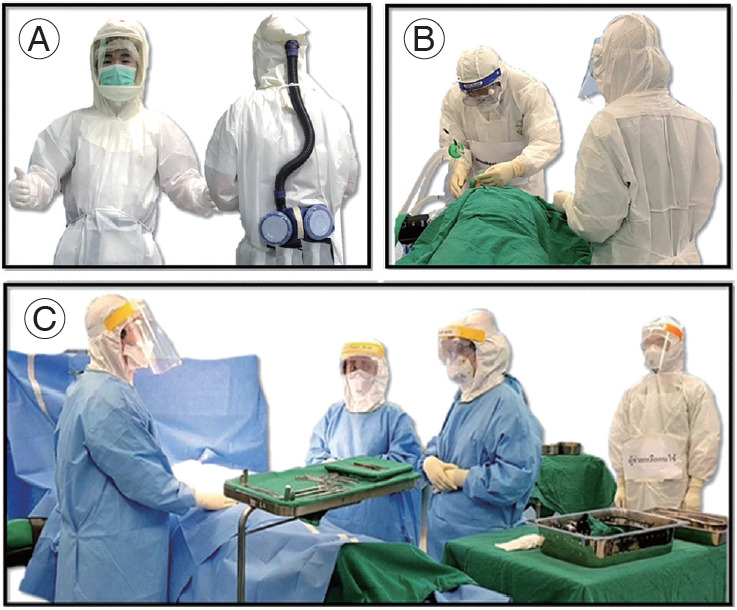Dear Sir,
We appreciate the letter regarding our manuscript titled “Management of traumatic spinal fracture in the coronavirus disease 2019 situation [1].” We would like to thank the reader/s for reading our article. Our reply to the comment is as follows:
Comment: “I read your paper in the Asian Spine Journal. I found your paper very interesting and your algorithm very informing. I am wondering what your institute uses specifically for “full personal protective equipment (PPE)” for the high risk patients, i.e., National Institute for Occupational Safety and Health-approved (N95) respirator, face shield, etc.”
Our reply: In this review article, the authors concluded that an algorithm could help make decisions about surgical interventions for spine injuries in patients who are at risk for coronavirus disease 2019 (COVID-19) to prevent surgeons and nurses from contracting the virus. In this situation, where the health care professionals are in contact with a high-risk patient, the surgeons and nurses could use full PPE suits (Fig. 1A). The authors recommended full PPE that is composed of fluid-resistant legs with shoe coverings, goggles, safety glasses, a face shield, a double layer of gloves, and a surgical mask that can be used with a standard N95 respirator [1]. A standard N95 respirator protects the wearer from exposure to airborne particles (e.g., dust, mist, fumes, fibers, and bioaerosols, such as viruses and bacteria) or respiratory system [2]. An impermeable gown that covers from the neck to at least the mid-thigh is the standard Centers for Disease Control and Prevention guideline [3,4].
Fig. 1.

The operative trailer: the health care professional uses a full PPE suit (A), airway management by anesthesiologists (B), and intraoperative standard with full PPE according to Centers for Disease Control and Prevention guidelines (C). PPE, personal protective equipment.
For a high-risk patient who needs emergency spine surgery, the surgeon could co-manage the airway with the anesthesiologists [5] and the COVID-19 team [1] (Fig. 1B). The operative room should be prepared with full PPE and a standardized surgical suit (Fig. 1C), and a postoperative isolation room or isolation surgical intensive care unit should be used.
The authors want to establish a prototype to help protect health care professionals [1]. The authors preferred that this algorithm be revised or modified according to the updated knowledge about prevention, novel treatment, and laboratory testing technology for COVID-19. Finally, all the authors hope that the journal’s readers will use this algorithm as a prototype and that is can be modified to develop a better protocol. The authors designed this algorithm for the management of traumatic spinal fractures during the COVID-19 situation because we believe in the philosophy of Prince Mahidol of Songkla’s that states “true success is not in the learning, but in its application to the benefit of mankind.”
Acknowledgments
Thank you to Chanon Sukjaroen, MD for the picture he provided of him wearing a full PPE suit. Thank you to Amornchai Kritnikornkul, MD and Prapon Piamanant, MD for the picture they provided showing co-management and following the authors’ algorithm. Thank you to the Institutional Ethics Review Board at Nakornping Hospital for proof of this picture and this letter.
Footnotes
No potential conflict of interest relevant to this article was reported.
References
- 1.Sornsa-Ard T, Niramitsantiphong A, Liawrungrueang W. Management of traumatic spinal fracture in the coronavirus disease 2019 situation. Asian Spine J. 2020 Apr 24; doi: 10.31616/asj.2019.0183. [Epub]. [DOI] [PMC free article] [PubMed] [Google Scholar]
- 2.3M Personal Safety Division . St. Paul (MN): 3M Personal Safety Division; 2020. Surgical N95 vs. standard N95: which to consider? [Internet] [cited 2020 Apr 26]. Available from: https://multimedia.3m.com/mws/media/1794572O/surgical-n95-vs-standardn95-which-to-consider.pdf. [Google Scholar]
- 3.Centers for Disease Control and Prevention . Atlanta (GA): Centers for Disease Control and Prevention; 2020. What healthcare personnel should know about caring for patients with confirmed or possible COVID-19 infection [Internet] [cited 2020 Mar 6]. Available from: http://www.cdc.gov/coronavirus/2019-ncov/hcp/caring-for-patients.html. [Google Scholar]
- 4.Centers for Disease Control and Prevention . Atlanta (GA): Centers for Disease Control and Prevention; 2020. Strategies for optimizing the supply of N95 respirators [Internet] [cited 2020 Apr 26]. Available from: https://www.cdc.gov/coronavirus/2019-ncov/hcp/respirators-strategy/index.html. [Google Scholar]
- 5.Lockhart SL, Duggan LV, Wax RS, Saad S, Grocott HP. Personal protective equipment (PPE) for both anesthesiologists and other airway managers: principles and practice during the COVID-19 pandemic. Can J Anaesth. 2020 Apr 23; doi: 10.1007/s12630-020-01673-w. [Epub]. [DOI] [PMC free article] [PubMed] [Google Scholar]


